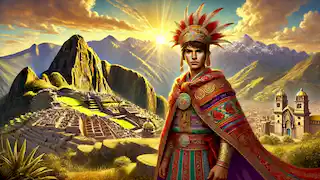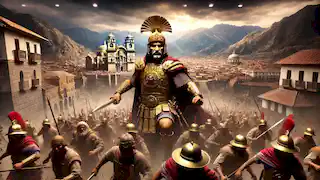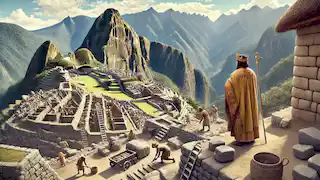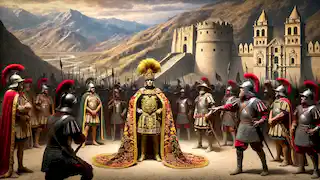The Tale of the Sapa Inca
Reading time: 8 min

About this story: The Tale of the Sapa Inca is a Historical Fiction from Peru set in the Ancient This Descriptive tale explores themes of Perseverance and is suitable for Adults. It offers Moral insights. The rise and fall of a divine emperor who shaped the Inca Empire.
Deep in the heart of the Andes mountains, a civilization flourished, one that would forever change the course of history in South America. The Inca Empire, at its zenith, stretched across vast territories, uniting cultures, people, and beliefs under the divine rule of the Sapa Inca. This is the story of the Sapa Inca, the emperor considered a living god, chosen by the Sun to rule over the land. This tale weaves through the golden streets of Cusco, ascends the sacred peaks of Machu Picchu, and follows the paths trodden by legions of warriors, priests, and artisans who built one of the greatest empires of the ancient world.
The Divine Birth
Long ago, in the land where the jagged peaks of the Andes touched the sky, a prophecy was whispered among the Quechua people. It spoke of a child, born of the Sun, destined to unite the fragmented peoples of the Andean highlands. When the child was born, the priests recognized the signs. The boy, called Pachacuti, was not like the others. He had a fierce gaze, the wisdom of someone far beyond his years, and a destiny that gleamed brighter than the gold that filled the sacred temples.
Pachacuti’s father, the reigning Sapa Inca, believed that his son was indeed chosen by the Sun God, Inti. As a young prince, Pachacuti was taught the ways of war, diplomacy, and the sacred ceremonies that connected the empire to the divine. His father, a powerful and revered ruler, felt assured that his lineage would be carried on through the young Pachacuti. However, he never could have predicted how his son would soon rise not only to inherit the empire but to expand it far beyond anyone’s imagination.

The Coming of War
Before Pachacuti could ascend the throne, the Inca Empire faced a great threat. A rival kingdom from the north, the Chanka, advanced on Cusco, the sacred city. The Chanka were fierce warriors, known for their cruelty in battle, and they had set their sights on Cusco. Pachacuti’s father, old and weary, decided to flee the city, convinced that Cusco would fall. But Pachacuti, young and brimming with the conviction that the Sun God had chosen him, refused to abandon the city.
Taking command of the few soldiers that remained, Pachacuti devised a strategy that would change the course of Incan history. He rallied the people of Cusco, inspiring them with visions of divine protection. He ordered the construction of fortifications and traps, turning the terrain of the Andes into a weapon against the invaders. The night before the battle, Pachacuti climbed to the top of a sacred mountain, offering prayers to Inti and vowing that he would dedicate his life to the Sun if he won.
When the Chanka warriors stormed the city, they were met not by a weakened defense but by a force driven by divine purpose. Pachacuti led his troops with a ferocity and brilliance that astounded even his enemies. The Chanka were defeated, and Cusco was saved. News of his victory spread throughout the Andes, and the people began to speak of him as a living god, one chosen to reshape the world.
The Golden Age of Expansion
After his father’s abdication, Pachacuti ascended to the throne as the new Sapa Inca. His vision for the empire extended far beyond Cusco. Where others saw mountains and valleys, Pachacuti saw potential. He understood that the strength of the Inca did not lie merely in military might but in unity and belief. To build the empire of his dreams, he needed to create a culture that transcended borders.
He began a campaign of conquest, uniting the fragmented kingdoms and tribes of the Andes under one banner. But Pachacuti was no ordinary conqueror. While his armies defeated enemy forces with precision, he offered those who submitted peacefully a place within his empire. He respected their traditions, incorporated their deities into the Inca pantheon, and built roads and structures that connected the most distant villages to the heart of Cusco.

The empire soon stretched from the deserts of the northern coast to the rainforests of the south, and from the edges of the Amazon to the Pacific Ocean. Pachacuti also reformed the Inca society, structuring it in a way that balanced the needs of the people with the demands of the state. A system known as *mit’a* was introduced, where labor was considered a form of tribute, and the wealth generated by the empire was distributed through massive public works.
One of the greatest achievements of Pachacuti’s reign was the construction of Machu Picchu, a sacred city high in the clouds. Built as a spiritual retreat for the emperor and his elite, it embodied the essence of Incan philosophy, where man, earth, and sky were intertwined in perfect harmony. Machu Picchu was not only a testament to the architectural prowess of the Inca but also a symbol of Pachacuti’s divine mandate.
The Sacred Duty of the Sapa Inca
The role of the Sapa Inca was not merely that of a ruler but of a divine intermediary. The emperor was believed to be the son of Inti, the Sun God, and his rule was seen as a continuation of the cosmic order. Every action the Sapa Inca took had to be in harmony with the natural and spiritual worlds. This belief system governed not only politics but also the daily lives of the Inca people.
Pachacuti took his sacred duties seriously. He ensured that rituals to honor the gods were carried out with precision. The most important festival, Inti Raymi, celebrated the Sun God and marked the beginning of a new year. Thousands gathered in the capital to witness the Sapa Inca lead the ceremonies, dressed in garments woven from the finest vicuña wool and adorned with golden jewelry that reflected the sun’s rays.
Under Pachacuti’s rule, the empire continued to thrive. Agriculture was revolutionized with the introduction of terrace farming, which allowed the Inca to cultivate crops on the steep slopes of the Andes. The empire’s vast network of roads, bridges, and storage facilities ensured that food and goods were distributed efficiently, even in times of drought or famine. These innovations helped sustain the empire’s growing population and secured Pachacuti’s legacy as not only a conqueror but also a visionary ruler.

The Fall of the Inca
Despite its grandeur, the Inca Empire was not invincible. After Pachacuti’s death, his successors continued to expand the empire, but internal strife began to take root. Power struggles among the royal family and the growing resentment of conquered peoples weakened the unity that Pachacuti had worked so hard to create.
The arrival of the Spanish conquistadors in the early 16th century marked the beginning of the end for the Inca. The empire, already weakened by a civil war between two rival brothers, Huáscar and Atahualpa, was no match for the advanced weapons and diseases brought by the Spanish. Atahualpa, the last Sapa Inca, was captured by Francisco Pizarro, and despite a massive ransom paid in gold and silver, he was executed.
The fall of the Inca Empire was swift and brutal. The Spanish dismantled the empire, destroyed temples, and looted its treasures. Yet, even in defeat, the legacy of Pachacuti and the Inca civilization endured. The ruins of their cities, the remnants of their roads, and the stories passed down through generations are testaments to a people who once ruled the sky-clad mountains with wisdom, strength, and faith in the divine.
Epilogue: The Legacy of the Sapa Inca
The story of the Sapa Inca is one of vision and endurance. Though the empire crumbled under the weight of foreign invasion, the spirit of the Inca people lived on. Today, the descendants of the Inca continue to honor their ancestors, preserving their language, Quechua, and their traditions. The ancient capital of Cusco still stands as a living museum of Inca architecture and culture, and Machu Picchu remains a symbol of the empire’s enduring legacy.

Pachacuti’s dream of a unified Andean world may have been cut short by the arrival of the Spanish, but his vision lives on in the hearts of those who remember the empire that once ruled the skies. The Tale of the Sapa Inca is not merely a story of a great empire’s rise and fall; it is a testament to the enduring power of belief, the strength of unity, and the will to persevere, even in the face of overwhelming odds.


















